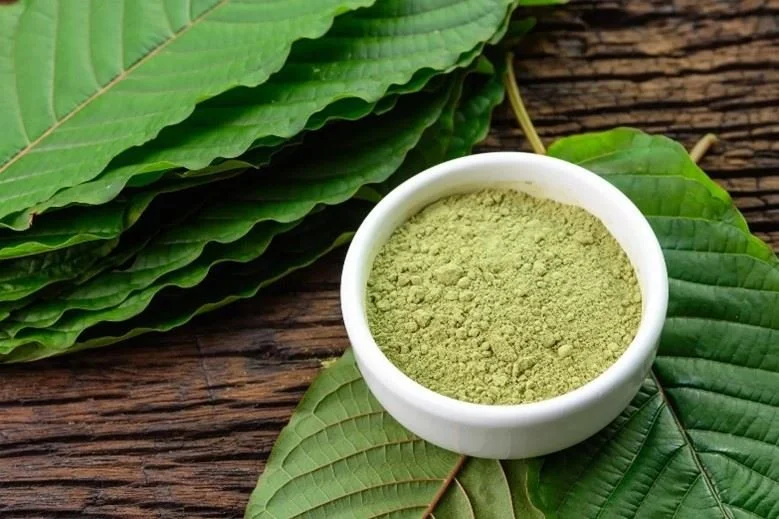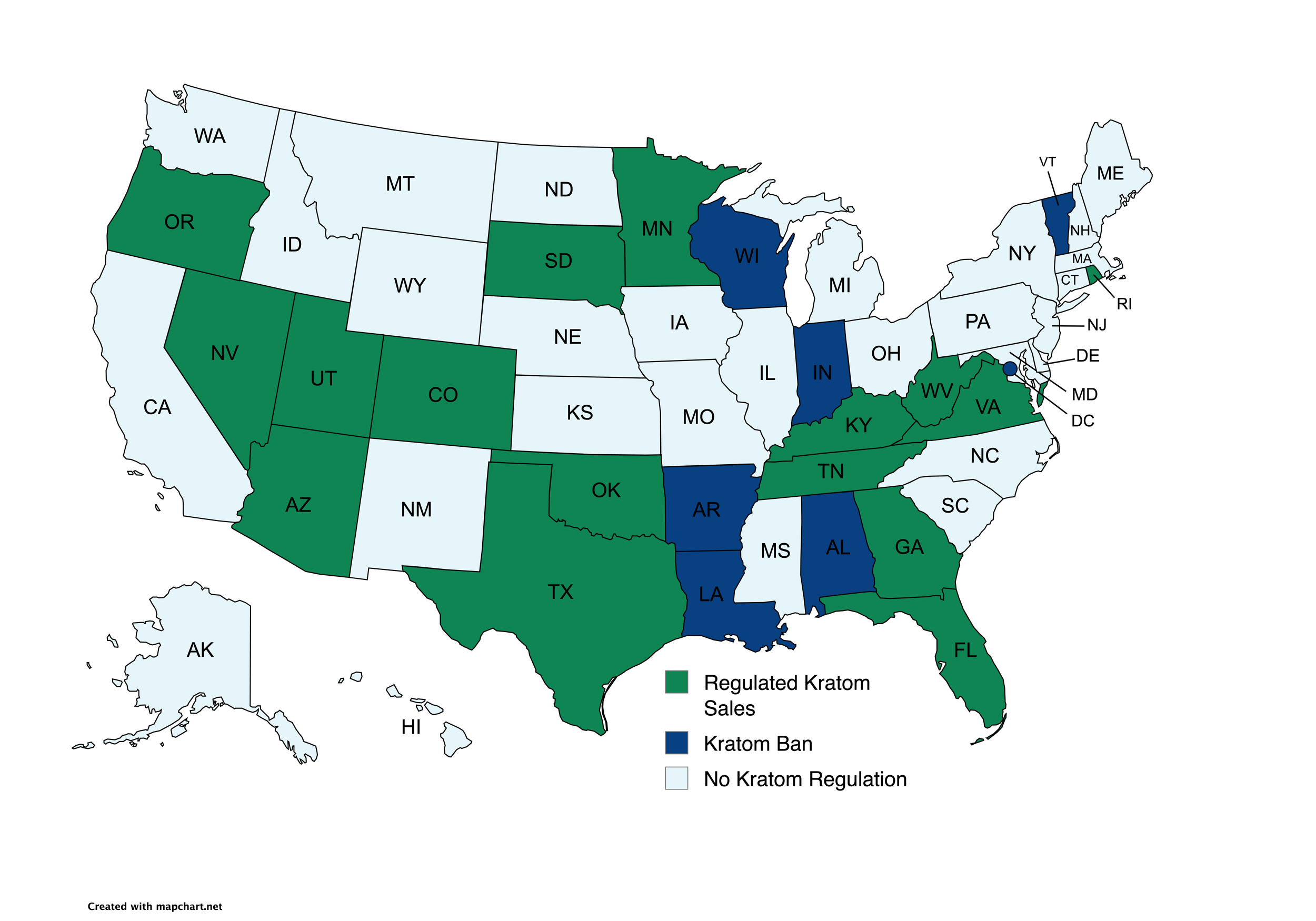
Kratom in West Virginia
This Science and Technology Note discusses the effects of kratom, West Virginia’s current kratom legislation, and federal and state actions to regulate kratom use.
Research Highlights
Kratom is opioid-like substance commonly used as a stimulant and pain reliever. Powder, capsules, and liquid preparations are readily available in convenience stores, vape shops, and online.
Research suggests that kratom affects many pathways in the brain, including opioid receptors.
West Virginia law requires that kratom distributors register products and obtain a license, limits sale to those over 21, and requires products to contain less than 2% 7-OH.
Six state and Washington, DC have banned kratom and kratom components. There has been discussion of federal scheduling of 7-OH, but no action has been taken to date.
Kratom is an evergreen tree native to southeast Asia whose leaves have long been chewed by farm workers to provide energy and focus, prevent fatigue, and ease pain and discomfort. The past two decades have seen kratom introduced to US markets, where it can commonly be found as powders, capsules, and liquid preparations in convenience stores, vape shops, or online. This S&T Notes discusses the effects of kratom, West Virginia’s current kratom legislation, and federal and state actions to regulate kratom use.
How Does Kratom Work?
Kratom leaves contain two main compounds known to produce opioid-like effects: mitragynine and 7-hydroxymitragynine, commonly known as 7-OH. These are naturally present in the leaves at low levels (2% and 0.02%, respectively). Once in the body, the liver converts mitragynine to 7-OH, and enzymes in the blood convert 7-OH to mitragynine pseudoindoxyl (MPI, often advertised as ‘pseudo’). Each metabolite is more potent than the last, with MPI being 20 times more potent than morphine. Many manufacturers are also supplementing natural kratom with increased levels of 7-OH and/or MPI to increase the effects of the drug.
Kratom components and metabolites (mitragynine, 7-OH, MPI) bind the same opioid receptors as morphine with increasing potency as they are metabolized in the liver and blood.
In the brain, kratom components bind the same opioid receptors as morphine, heroin, or fentanyl. They can also bind other receptors, which is why at low doses it can be considered a stimulant. However, at moderate to high doses it acts similarly to more traditional opioids, causing relaxation, sedation, and pain relief. Some studies have suggested that kratom may have fewer dangerous side effects than prescribed opioids, but this is widely debated. As kratom affects many pathways in the brain, it can interact with other drugs such as benzodiazepines, alcohol, Imodium, SSRIs, SNRIs, and Seroquel and result in severe side effects, including death. There are currently numerous wrongful death lawsuits against kratom distributors.
| Kratom Use | Dose (powder or extract) | Effects |
|---|---|---|
| Low-Moderate | 1-5 grams | Mild stimulant |
| Moderate-High | 5-15 grams | Opioid-like effects (pain relief, euphoria) |
| Very High | >15 grams | Sedation |
Adapted from Chien et al., 2017.
Overdoses from kratom alone are fairly rare, but do occur. Because kratom primarily binds to opioid receptors, the effects may be reversed through administration of naloxone (Narcan). Studies suggest that long-term use can lead to dependence (addiction) that could require medication-assisted treatment such as Sublocade or Suboxone. However, many kratom advocates claim that it has helped them quit opioids and ease chronic pain. The extent of kratom use and dependence has not been investigated since 2021, when kratom users were estimated to be about 0.8% of the US population (2 million people). More recent estimates are around 15 million people, but the methods and reliability of those numbers are unclear.
West Virginia Kratom Law
Although the prevalence of kratom use in West Virginia is unknown, the Deputy Commissioner of the WV Department of Agriculture recently reported over $180,000 in tax revenue from kratom sales in the last quarter. SB 220 (2023) created the Select Plant-Derived Regulation Act: Kratom to require permits for the manufacture, processing, and sale of kratom in the state. It limited sales to persons over 21 with age verification, placed an 11% tax on retail sales, established packaging requirements, and created state-level enforcement systems. The WV Department of Agriculture has implemented additional restrictions, including that products must contain less than 2% 7-OH. However, it is important to note that there are numerous online vendors that sell kratom and 7-OH products with shipping available to West Virginia, and customers must only click a button to confirm they are over 21, with no identification necessary.
Kratom Policy Options
Kratom is not a federally controlled substance, though the Food and Drug Administration (FDA) has warned consumers against use and has stated that kratom is not a legal dietary supplement or food additive. In July 2025, the FDA recommended that the DEA classify 7-OH as a Schedule I controlled substance, but no action has been taken to date. As such, kratom restrictions have been left to state policymakers.
As of April 2025, 6 states (Alabama, Arkansas, Indiana, Louisiana, Vermont, and Wisconsin) and Washington, DC have banned all kratom products as controlled substances, including the psychoactive components. 18 additional states, including West Virginia, regulate the possession, sale, and manufacture of kratom. Ohio’s Governor DeWine has recently called for a full ban on natural and synthetic kratom, calling it an “imminent public health risk”.
Map of Kratom Regulation by State. Adapted from a Legislative Analysis and Public Policy Association Report.
This Science and Technology Note was prepared by Kensey Bergdorf-Smith, PhD, on behalf of the West Virginia Science and Technology Policy (WV STeP) Initiative. The WV STeP Initiative provides nonpartisan research and information to members of the West Virginia Legislature. This Note is intended for informational purposes only and does not indicate support or opposition to a particular bill or policy approach. Please contact info@wvstep.org for more information.

